7 items to eat and drink on a luxury trip to Marrakech, Morocco
Marrakech, Morocco is not only a wonderful romantic getaway – it’s a fascinating foodie destination as well. Don’t miss trying both exotic Moroccan delicacies as well as some healthy, locally grown foods. Read on for our seven ideas to satisfy your appetite on your next visit to Morocco’s fourth largest city.
Traditional tagine
Tagines and the tagine clay pots used for cooking them are ubiquitous in Marrakech and Morocco, from humble Berber homes and weekly markets to the Moroccan fine dining restaurants of Marrakech luxury hotels.
 Our most memorable tagine was eaten as lunch guests in a traditional Berber home, after an invigorating walk up a hill in the cool mountain air. Layers of fresh vegetables ensconced meltingly tender beef, and we captured every last bit of the delicious juices with fresh hearth baked Moroccan bread. Our experience, which included a visit to the weekly market in L’Arbaa Tighdouine and spectacular views of the Atlas Mountains, was arranged by Amanjena and is highly recommended.
Bastilla
Even before visiting Marrakech, Bastilla was one of my favorite dishes, and is quintessentially Moroccan. Traditionally Bastilla is a phyllo encased savory pastry, made with a pigeon or squab filling flavored with saffron and a savory-sweet spice mix called ras el hanout (literally, “top of the shop,” since each spice vendor makes his or her own special mix). Nowadays sometimes seafood or other versions are made, but I suggest trying the original.
Our most memorable tagine was eaten as lunch guests in a traditional Berber home, after an invigorating walk up a hill in the cool mountain air. Layers of fresh vegetables ensconced meltingly tender beef, and we captured every last bit of the delicious juices with fresh hearth baked Moroccan bread. Our experience, which included a visit to the weekly market in L’Arbaa Tighdouine and spectacular views of the Atlas Mountains, was arranged by Amanjena and is highly recommended.
Bastilla
Even before visiting Marrakech, Bastilla was one of my favorite dishes, and is quintessentially Moroccan. Traditionally Bastilla is a phyllo encased savory pastry, made with a pigeon or squab filling flavored with saffron and a savory-sweet spice mix called ras el hanout (literally, “top of the shop,” since each spice vendor makes his or her own special mix). Nowadays sometimes seafood or other versions are made, but I suggest trying the original.
 I particularly recommend the large feast size version made at the Four Seasons Marrakech Solano restaurant for special Moroccan buffet nights.
Mrouzia
Mrouzia is a rich dish of honeyed, spiced lamb, often with raisins or prunes and almonds added to the sauce. It dates back to times when there was no refrigeration, so fat and honey helped to preserve the meat. An excellent version is available at Solano on Moroccan buffet nights.
Moroccan mint tea
Moroccans drink mint tea several times during the day, and it is common to be served it both before a meal and afterwards. The first brewed cup of tea is usually murky and discarded, and a properly brewed cup of tea should have some foam atop it, from the aeration of being poured from high up, be sweet from the dissolved sugar, and have a wonderfully fragrant herbal aroma and taste from mint and possibly other herbs (fresh sage and rosemary are sometimes used).
I particularly recommend the large feast size version made at the Four Seasons Marrakech Solano restaurant for special Moroccan buffet nights.
Mrouzia
Mrouzia is a rich dish of honeyed, spiced lamb, often with raisins or prunes and almonds added to the sauce. It dates back to times when there was no refrigeration, so fat and honey helped to preserve the meat. An excellent version is available at Solano on Moroccan buffet nights.
Moroccan mint tea
Moroccans drink mint tea several times during the day, and it is common to be served it both before a meal and afterwards. The first brewed cup of tea is usually murky and discarded, and a properly brewed cup of tea should have some foam atop it, from the aeration of being poured from high up, be sweet from the dissolved sugar, and have a wonderfully fragrant herbal aroma and taste from mint and possibly other herbs (fresh sage and rosemary are sometimes used).
 Fresh oranges
Orange groves are abundant in Marrakech, and every day I enjoyed eating fresh oranges and drinking some of the best fresh squeezed orange juice I’ve ever tasted.
Fresh oranges
Orange groves are abundant in Marrakech, and every day I enjoyed eating fresh oranges and drinking some of the best fresh squeezed orange juice I’ve ever tasted.
 Argan oil
I’d never heard of Argan oil before visiting Marrakech, which perhaps isn’t surprising given that the Argan Tree only grows in Morocco. Argan nuts are too bitter to eat, but are rich in Vitamin E, phenols, carotene, and fatty acids that are said to help protect against cardiovascular disease and cancer. Argan nuts are roasted and ground to make oil for eating and for use in beauty treatments. A simple and favorite Moroccan way to enjoy the oil is to dip fresh bread first into the oil, then into honey, to enjoy with Moroccan mint tea.
Argan oil
I’d never heard of Argan oil before visiting Marrakech, which perhaps isn’t surprising given that the Argan Tree only grows in Morocco. Argan nuts are too bitter to eat, but are rich in Vitamin E, phenols, carotene, and fatty acids that are said to help protect against cardiovascular disease and cancer. Argan nuts are roasted and ground to make oil for eating and for use in beauty treatments. A simple and favorite Moroccan way to enjoy the oil is to dip fresh bread first into the oil, then into honey, to enjoy with Moroccan mint tea.
 Thai food
If by chance you need a break from traditional Moroccan cuisine, there is surprisingly great Thai food in Marrakech, at Amanjena. Fresh Thai ingredients are flown in to prepare authentic Thai dishes such as spicy Panang curry with peanut and kaffir lime leaves.
Thai food
If by chance you need a break from traditional Moroccan cuisine, there is surprisingly great Thai food in Marrakech, at Amanjena. Fresh Thai ingredients are flown in to prepare authentic Thai dishes such as spicy Panang curry with peanut and kaffir lime leaves.
 What are your favorite things to eat and drink in Marrakech?
Hilary Stockton is the CEO at TravelSort.
If you would like to be a guest blogger on A Luxury Travel Blog in order to raise your profile, please contact us.
What are your favorite things to eat and drink in Marrakech?
Hilary Stockton is the CEO at TravelSort.
If you would like to be a guest blogger on A Luxury Travel Blog in order to raise your profile, please contact us.
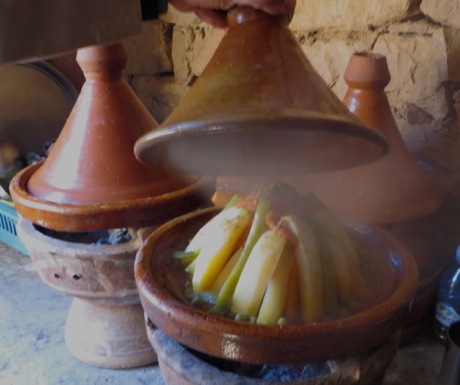 Our most memorable tagine was eaten as lunch guests in a traditional Berber home, after an invigorating walk up a hill in the cool mountain air. Layers of fresh vegetables ensconced meltingly tender beef, and we captured every last bit of the delicious juices with fresh hearth baked Moroccan bread. Our experience, which included a visit to the weekly market in L’Arbaa Tighdouine and spectacular views of the Atlas Mountains, was arranged by Amanjena and is highly recommended.
Bastilla
Even before visiting Marrakech, Bastilla was one of my favorite dishes, and is quintessentially Moroccan. Traditionally Bastilla is a phyllo encased savory pastry, made with a pigeon or squab filling flavored with saffron and a savory-sweet spice mix called ras el hanout (literally, “top of the shop,” since each spice vendor makes his or her own special mix). Nowadays sometimes seafood or other versions are made, but I suggest trying the original.
Our most memorable tagine was eaten as lunch guests in a traditional Berber home, after an invigorating walk up a hill in the cool mountain air. Layers of fresh vegetables ensconced meltingly tender beef, and we captured every last bit of the delicious juices with fresh hearth baked Moroccan bread. Our experience, which included a visit to the weekly market in L’Arbaa Tighdouine and spectacular views of the Atlas Mountains, was arranged by Amanjena and is highly recommended.
Bastilla
Even before visiting Marrakech, Bastilla was one of my favorite dishes, and is quintessentially Moroccan. Traditionally Bastilla is a phyllo encased savory pastry, made with a pigeon or squab filling flavored with saffron and a savory-sweet spice mix called ras el hanout (literally, “top of the shop,” since each spice vendor makes his or her own special mix). Nowadays sometimes seafood or other versions are made, but I suggest trying the original.
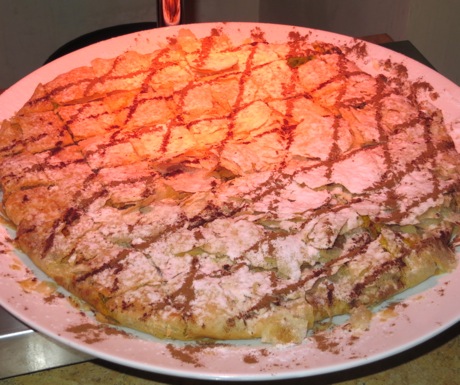 I particularly recommend the large feast size version made at the Four Seasons Marrakech Solano restaurant for special Moroccan buffet nights.
Mrouzia
Mrouzia is a rich dish of honeyed, spiced lamb, often with raisins or prunes and almonds added to the sauce. It dates back to times when there was no refrigeration, so fat and honey helped to preserve the meat. An excellent version is available at Solano on Moroccan buffet nights.
Moroccan mint tea
Moroccans drink mint tea several times during the day, and it is common to be served it both before a meal and afterwards. The first brewed cup of tea is usually murky and discarded, and a properly brewed cup of tea should have some foam atop it, from the aeration of being poured from high up, be sweet from the dissolved sugar, and have a wonderfully fragrant herbal aroma and taste from mint and possibly other herbs (fresh sage and rosemary are sometimes used).
I particularly recommend the large feast size version made at the Four Seasons Marrakech Solano restaurant for special Moroccan buffet nights.
Mrouzia
Mrouzia is a rich dish of honeyed, spiced lamb, often with raisins or prunes and almonds added to the sauce. It dates back to times when there was no refrigeration, so fat and honey helped to preserve the meat. An excellent version is available at Solano on Moroccan buffet nights.
Moroccan mint tea
Moroccans drink mint tea several times during the day, and it is common to be served it both before a meal and afterwards. The first brewed cup of tea is usually murky and discarded, and a properly brewed cup of tea should have some foam atop it, from the aeration of being poured from high up, be sweet from the dissolved sugar, and have a wonderfully fragrant herbal aroma and taste from mint and possibly other herbs (fresh sage and rosemary are sometimes used).
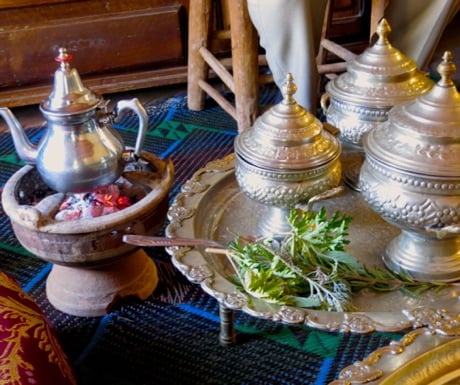 Fresh oranges
Orange groves are abundant in Marrakech, and every day I enjoyed eating fresh oranges and drinking some of the best fresh squeezed orange juice I’ve ever tasted.
Fresh oranges
Orange groves are abundant in Marrakech, and every day I enjoyed eating fresh oranges and drinking some of the best fresh squeezed orange juice I’ve ever tasted.
 Argan oil
I’d never heard of Argan oil before visiting Marrakech, which perhaps isn’t surprising given that the Argan Tree only grows in Morocco. Argan nuts are too bitter to eat, but are rich in Vitamin E, phenols, carotene, and fatty acids that are said to help protect against cardiovascular disease and cancer. Argan nuts are roasted and ground to make oil for eating and for use in beauty treatments. A simple and favorite Moroccan way to enjoy the oil is to dip fresh bread first into the oil, then into honey, to enjoy with Moroccan mint tea.
Argan oil
I’d never heard of Argan oil before visiting Marrakech, which perhaps isn’t surprising given that the Argan Tree only grows in Morocco. Argan nuts are too bitter to eat, but are rich in Vitamin E, phenols, carotene, and fatty acids that are said to help protect against cardiovascular disease and cancer. Argan nuts are roasted and ground to make oil for eating and for use in beauty treatments. A simple and favorite Moroccan way to enjoy the oil is to dip fresh bread first into the oil, then into honey, to enjoy with Moroccan mint tea.
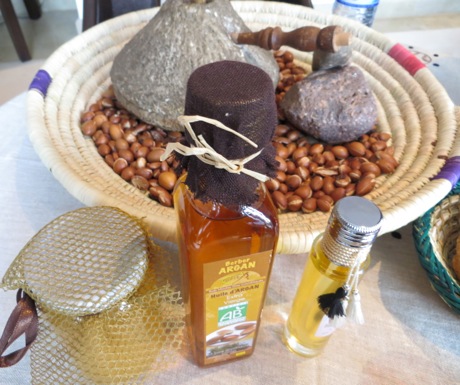 Thai food
If by chance you need a break from traditional Moroccan cuisine, there is surprisingly great Thai food in Marrakech, at Amanjena. Fresh Thai ingredients are flown in to prepare authentic Thai dishes such as spicy Panang curry with peanut and kaffir lime leaves.
Thai food
If by chance you need a break from traditional Moroccan cuisine, there is surprisingly great Thai food in Marrakech, at Amanjena. Fresh Thai ingredients are flown in to prepare authentic Thai dishes such as spicy Panang curry with peanut and kaffir lime leaves.
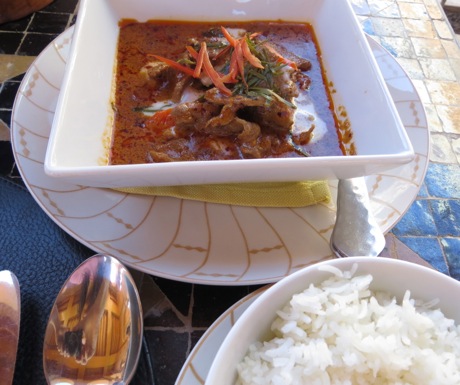 What are your favorite things to eat and drink in Marrakech?
Hilary Stockton is the CEO at TravelSort.
If you would like to be a guest blogger on A Luxury Travel Blog in order to raise your profile, please contact us.
What are your favorite things to eat and drink in Marrakech?
Hilary Stockton is the CEO at TravelSort.
If you would like to be a guest blogger on A Luxury Travel Blog in order to raise your profile, please contact us.Did you enjoy this article?
Receive similar content direct to your inbox.


You forgot to mention the delicious and pure North-African couscous, usually served on Fridays, with different combinations of vegetables, the most famous is “couscous with 7 types of vegetables”. A very rich and yet light meal. you should try it!!
Bissara is also a Moroccan popular dish prepared from dried and peeled fava-beans. It is prepared more often during the cold seasons because of the energy it provides for the body. Bissara is usually served with olive oil and hot spices on the top. Although it is prepared also by the rich people, it remains more prevalent amid the working class.
Also in morocco we have chicken tajine with lemon – is very common.
Hello thank you for sharing this amazin article, Did you use argan oil for coocking?
Zalouk (also spelled zaalouk) is a common side dish and typically served with crusty bread. The spread is made with eggplants, tomatoes, garlic, olive oil and spices.
Chicken with lemon tagine is always my favorite! I like your post